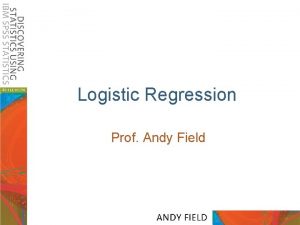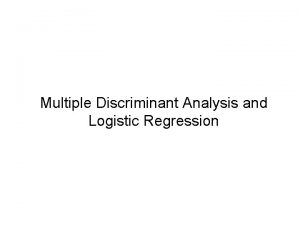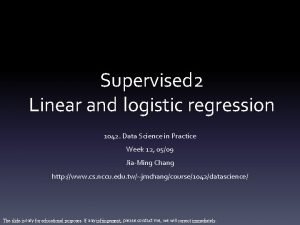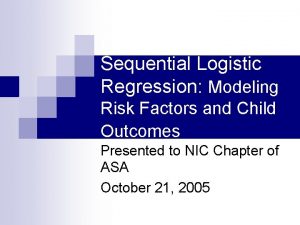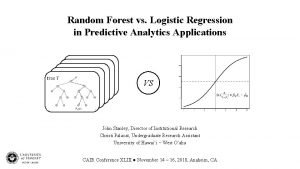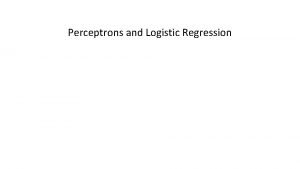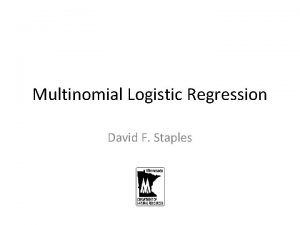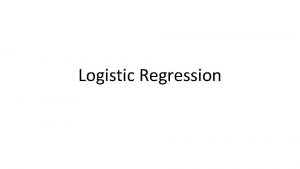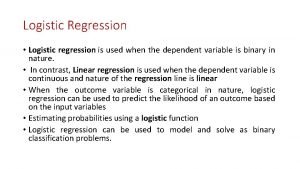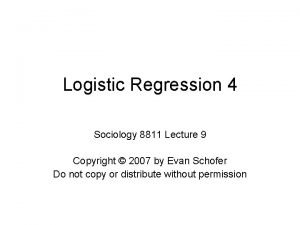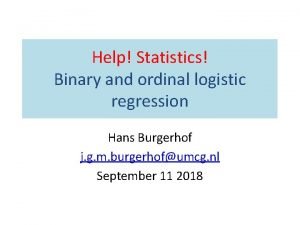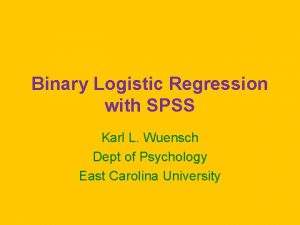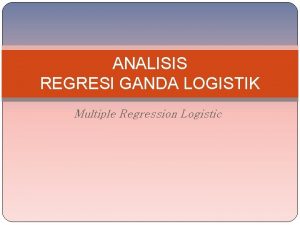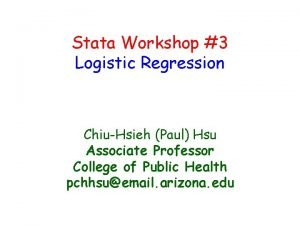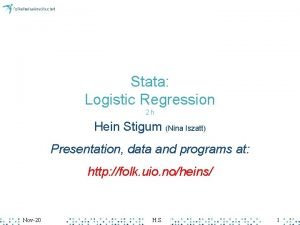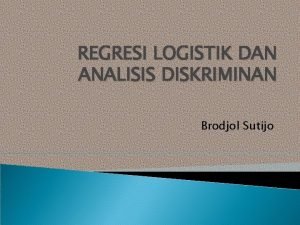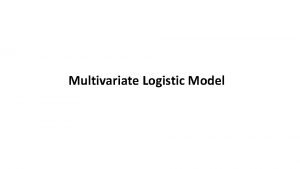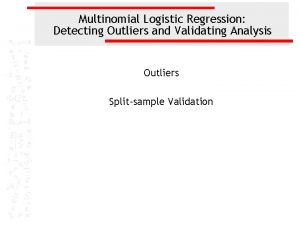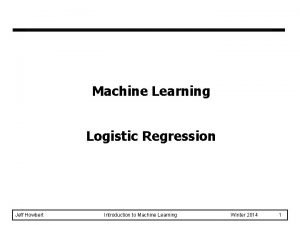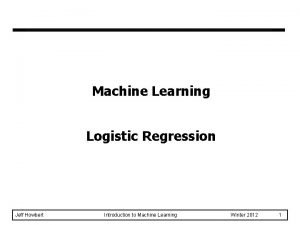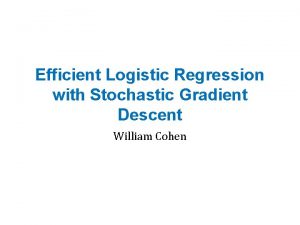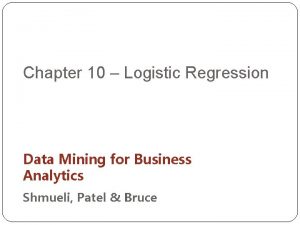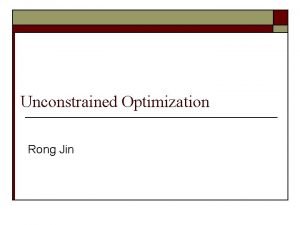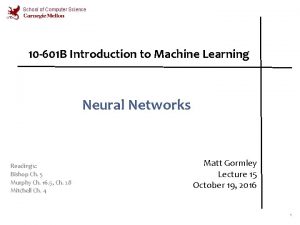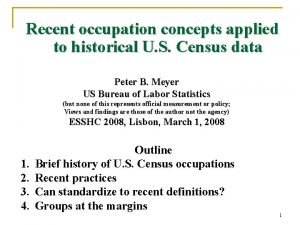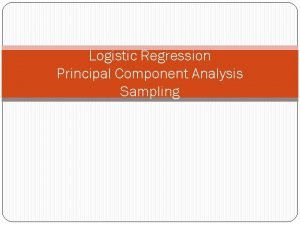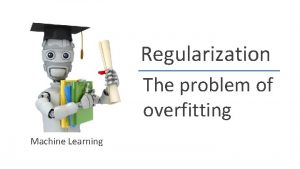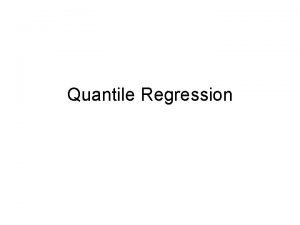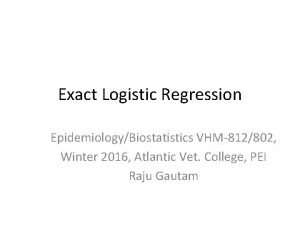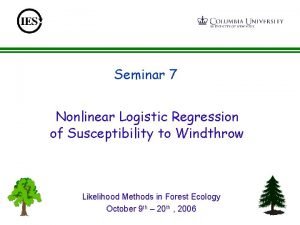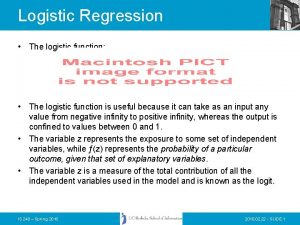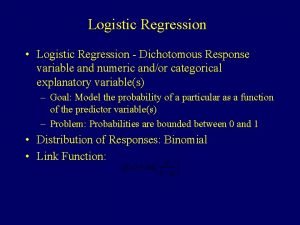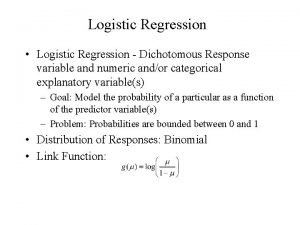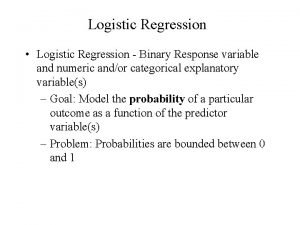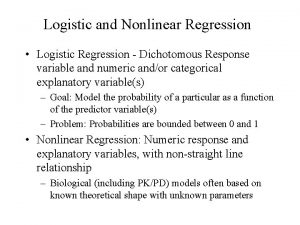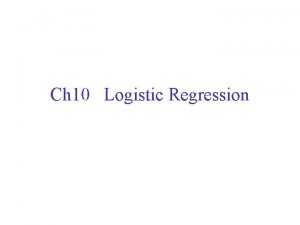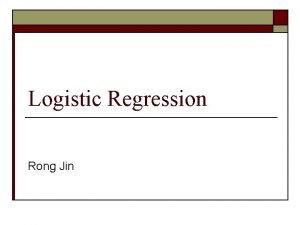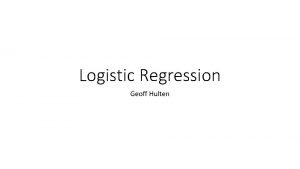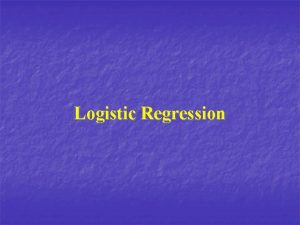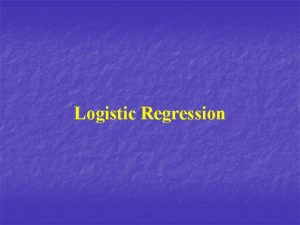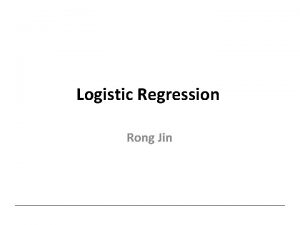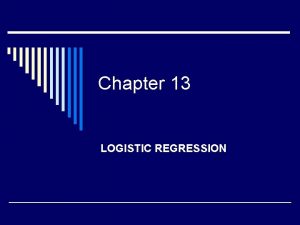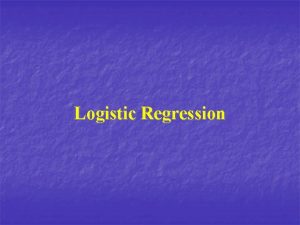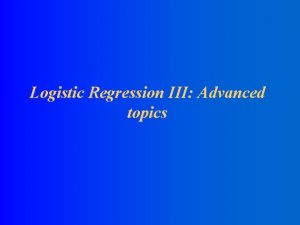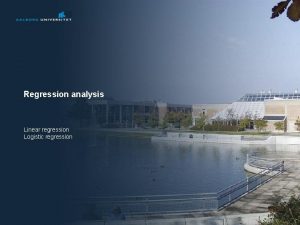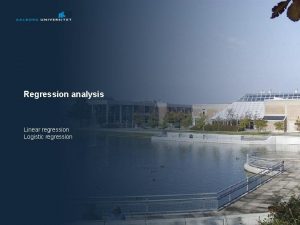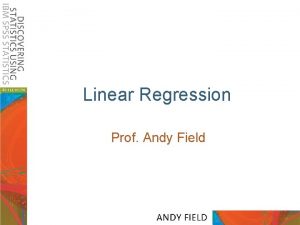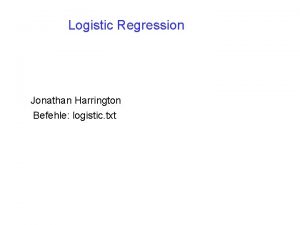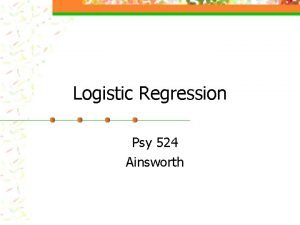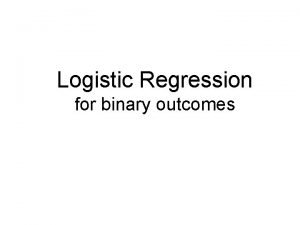Logistic Regression Prof Andy Field Aims When and





































- Slides: 37

Logistic Regression Prof. Andy Field

Aims • When and why do we use logistic regression? – Binary – Multinomial • Theory behind logistic regression – Assessing the model – Assessing predictors – Things that can go wrong • Interpreting logistic regression Slide

When and Why • To predict an outcome variable that is categorical from one or more categorical or continuous predictor variables. • Used because having a categorical outcome variable violates the assumption of linearity in normal regression. Slide

With one Predictor • Outcome – We predict the probability of the outcome = response category (Y = 1) occurring • b 0 and b 1 – Can be thought of in much the same way as multiple regression – Note the normal regression equation forms part of the logistic regression equation Slide 4

With Several Predictors • Outcome – We still predict the probability of the outcome = response category (Y = 1) occurring • Differences – Note the multiple regression equation forms part of the logistic regression equation – This part of the equation expands to accommodate additional predictors Slide 5

Assessing the Model: the loglikelihood statistic • The Log-likelihood statistic – Analogous to the residual sum of squares in multiple regression – It is an indicator of how much unexplained information there is after the model has been fitted. – Large values indicate poorly fitting statistical models.

Assessing the Model: the deviance statistic • The deviance is very closely related to the log -likelihood: it’s given by – Deviance = − 2 × log-likelihood • It’s possible to calculate a log-likelihood or deviance for different models and to compare these models by looking at the difference between their deviances.

Assessing the model: R and RL 2 • This R-statistic – is the partial correlation between the outcome variable and each of the predictor variables. – It can vary between − 1 and 1. • The R-statistic is given by: • Or, recommended:

Assessing Predictors: The Wald Statistic • • Slide 9 Similar to t-statistic in Regression. Tests the null hypothesis that b = 0. Is biased when b is large. Better to look at Likelihood-ratio statistics.

Treatment After food (coded as 1) After affection (coded as 0) Total Slide 10 Odds ratio (1) Outcome Dancing Not dancing (coded as 1) (coded as 0) 28 10 Total 38 48 114 162 76 Odds 124 200

Odds ratio (2) Decision Refer (coded as 1) Do not refer (coded as 0) Total Slide 11 Gender Male (coded as 1) Total Female (coded as 0) 7 3 10 3 7 10 10 Odds 10 20

The odds ratio: exp(B) • Indicates the change in odds resulting from a unit increase in the predictor. – OR > 1: predictor , probability of outcome occurring . – OR < 1: predictor , probability of outcome occurring . Slide 12

Methods of Regression • Forced Entry: all variables entered simultaneously. • Hierarchical: variables entered in blocks. – Blocks should be based on past research, or theory being tested. Good method. • Stepwise: variables entered on the basis of statistical criteria (i. e. relative contribution to predicting outcome). – Should be used only for exploratory analysis. Slide

Model building and Parsimony • When building a model we should strive for parsimony. – predictors should not be included unless they have explanatory benefit. • First fit the model that includes all potential predictors, and then systematically remove any that do not seem to contribute to the model.

Things That Can go Wrong • Assumptions from linear regression: – Linearity of the logit with each predictor – Independence of errors – Multicollinearity • Unique problems – Incomplete information – Complete separation – Overdispersion

Incomplete Information from the Predictors • Categorical Predictors: – Predicting cancer from smoking and eating tomatoes. – We don’t know what happens when non-smokers eat tomatoes because we have no data in this cell of the design. • Continuous variables – Will your sample contain a to include an 80 -year old, highly anxious, Buddhist left-handed lesbian?

Complete Separation • When the outcome variable can be perfectly predicted. – E. g. predicting whether someone is a burglar or your teenage son or your cat based on weight. – Weight is a perfect predictor of cat/burglar unless you have a very fat cat indeed!

Overdispersion • Overdispersion occurs when the variance is larger than expected from the model. • This can be caused by violating the assumption of independence. • This problem makes the standard errors of the b-values too small!

An Example • Predictors of a treatment intervention. • Participants – 113 adults with a medical problem • Outcome: – Cured (1) or not cured (0). • Predictors: – Intervention: intervention or no treatment. – Duration: the number of days before treatment that the patient had the problem. Slide

Output: Initial Model

Output: Initial analysis

Output: Block 0

Output: Model Summary

Output: Model Summary

Model Summary

Classification Plot

Summary • The overall fit of the final model is shown by − 2 LL and its associated chi-square statistic. – If the significance of the chi-square statistic of the difference between two -2 LLs is less than. 05, then the model is a significant improvement in fit with the data. • Check the table labelled Variables in the equation to see the regression parameters for any predictors in the model. • Look at the Wald statistic and its significance. • Use the odds ratio, Exp(B), for interpretation. – OR > 1, then as the predictor increases, the odds of the outcome occurring increase. – OR < 1, then as the predictor increases, the odds of the outcome occurring decrease. – The confidence interval of Exp(B) should not cross 1.

Reporting the Analysis Correction: in the table, replace R 2 with RL 2; replace Odds with Odds ratio or Point estimate.

Conclusion • With nominal dependent variable and nominal of continuous predictors, use logistic regression • Predicts p(DV = response category) • RL 2 in logistic regression: similar to R 2 in multiple regression • Odds ratio (OR): effect size – OR = exp(b) • Tests in logistic regression use 2 -distribution (multiple regression uses t- and F - distributions) – Log-likelihood statistic (model) – Hosmer-Lemeshow test (model) – Wald statistic (predictors) Slide

Multinomial logistic regression • Logistic regression to predict membership of more than two categories. • It (basically) works in the same way as binary logistic regression. • The analysis breaks the outcome variable down into a series of comparisons between two categories. – E. g. , if you have three outcome categories (A, B and C), then the analysis will consist of two comparisons that you choose: • Compare everything against your first category (e. g. A vs. B and A vs. C), • Or your last category (e. g. A vs. C and B vs. C), • Or a custom category (e. g. B vs. A and B vs. C). • The important parts of the analysis and output are much the same as we have just seen for binary logistic regression

I may not be Fred Flintstone … • How successful are chat-up lines? • The chat-up lines used by 348 men and 672 women in a nightclub were recorded. • Outcome: – Whether the chat-up line resulted in one of the following three events: • The person got no response or the recipient walked away, • The person obtained the recipient’s phone number, • The person left the night-club with the recipient. • Predictors: – The content of the chat-up lines were rated for: • Funniness (0 = not funny at all, 10 = the funniest thing that I have ever heard) • Sexuality (0 = no sexual content at all, 10 = very sexually direct) • Moral vales (0 = the chat-up line does not reflect good characteristics, 10 = the chat-up line is very indicative of good characteristics). – Gender of recipient

Output I

Output II

Output III

Interpretation I • Good_Mate: Whether the chat-up line showed signs of good moral fibre did not significantly predict whether you went home with the date or got a slap in the face, b = 0. 13, Wald χ2(1) = 2. 42, p =. 120. • Funny: Whether the chat-up line was funny significantly predicted whether you went home with the date or no response, b = 0. 32, Wald χ2(1) = 6. 46, p =. 011. • Gender: The gender of the person being chatted up significantly predicted whether they went home with the person or gave no response, b = − 5. 63, Wald χ2(1) = 17. 93, p <. 001. • Sex: The sexual content of the chat-up line significantly predicted whether you went home with the date or got a slap in the face, b = 0. 42, Wald χ2(1) = 11. 68, p =. 001.

Interpretation II • Funny × Gender: The success of funny chatup lines depended on whether they were delivered to a man or a woman because in interaction these variables predicted whether or not you went home with the date, b = 1. 17, Wald χ2(1) = 34. 63, p <. 001. • Sex × Gender: The success of chat-up lines with sexual content depended on whether they were delivered to a man or a woman because in interaction these variables predicted whether or not you went home with the date, b = − 0. 48, Wald χ2(1) = 8. 51, p =. 004.

Reporting the Results
 Andy field logistic regression
Andy field logistic regression Logistic regression vs linear regression
Logistic regression vs linear regression Logistic regression vs linear regression
Logistic regression vs linear regression Logistic regression and discriminant analysis
Logistic regression and discriminant analysis Null deviance vs residual deviance
Null deviance vs residual deviance Sequential logistic regression
Sequential logistic regression Logistic regression vs random forest
Logistic regression vs random forest Perceptron
Perceptron Multinomial logistic regression
Multinomial logistic regression Cost function logistic regression
Cost function logistic regression Logistic regression
Logistic regression Multinomial logistic regression
Multinomial logistic regression Logistic regression epidemiology
Logistic regression epidemiology Hosmer lemeshow test
Hosmer lemeshow test Karl wuensch
Karl wuensch Regresi logistik berganda adalah
Regresi logistik berganda adalah Logistic regression stata
Logistic regression stata Logistic regression stata
Logistic regression stata Logistic regression interaction interpretation
Logistic regression interaction interpretation Perbedaan analisis diskriminan dan regresi logistik
Perbedaan analisis diskriminan dan regresi logistik Univariate vs multivariate logistic regression
Univariate vs multivariate logistic regression Logistic regression outlier
Logistic regression outlier Advantage of logistic regression
Advantage of logistic regression Disadvantages of logistic regression
Disadvantages of logistic regression Logistic regression stochastic gradient descent
Logistic regression stochastic gradient descent Logistic regression spark
Logistic regression spark Logistic regression in data mining
Logistic regression in data mining Logistic regression optimization
Logistic regression optimization 601(b)(10)
601(b)(10) Logistic regression assignment
Logistic regression assignment Pca logistic regression
Pca logistic regression Logistic regression backpropagation
Logistic regression backpropagation Backpropagation logistic regression
Backpropagation logistic regression Logistic regression andrew ng
Logistic regression andrew ng Intuition psychology example
Intuition psychology example Octave tutorial machine learning
Octave tutorial machine learning Exact logistic regression
Exact logistic regression Nonlinear logistic regression
Nonlinear logistic regression
